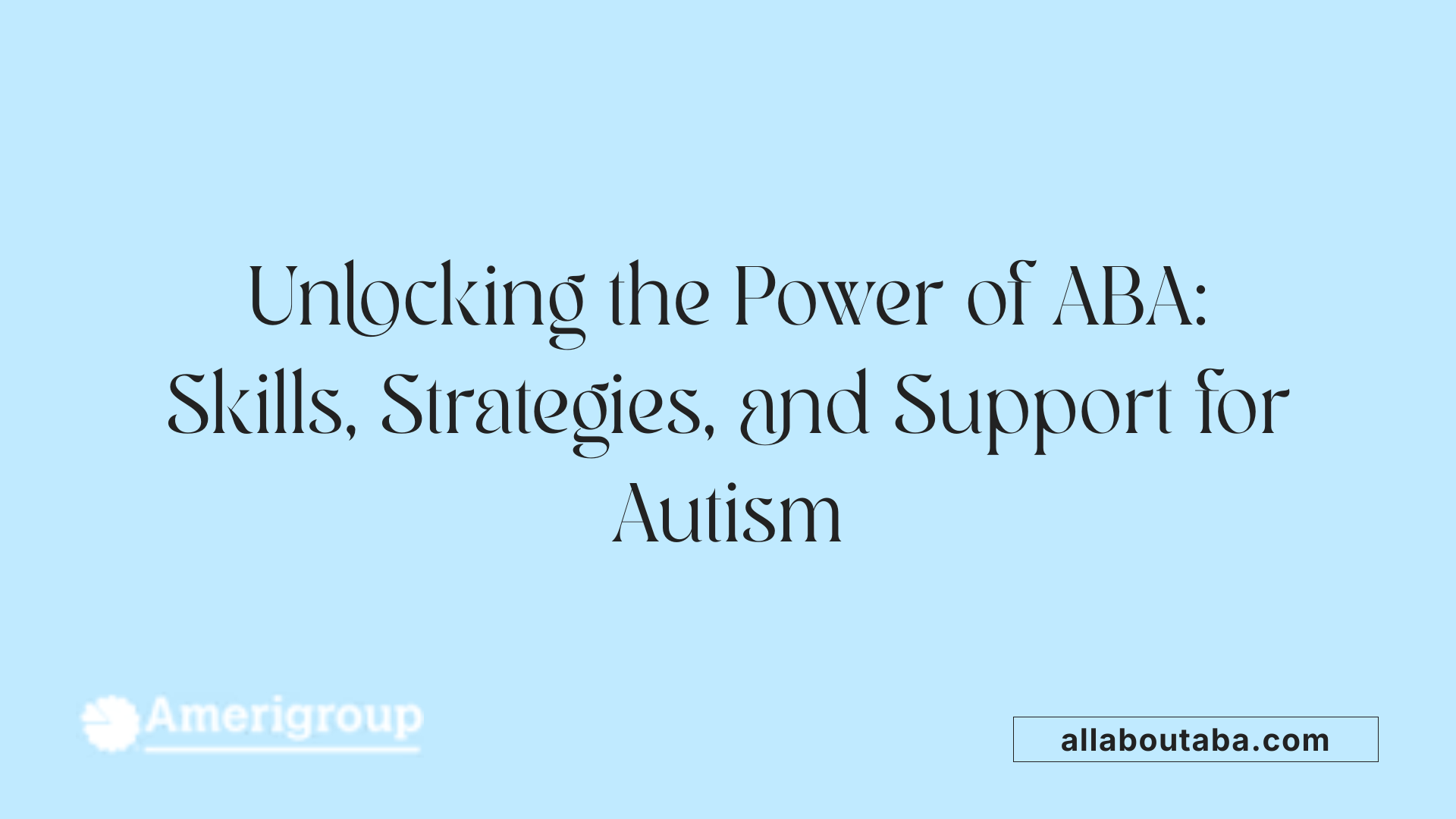How To Teach Decision-Making Skills To Autistic Young Adults
The Importance of Decision-Making Skills in Autism Support
Developing decision-making skills is a crucial step towards fostering independence and self-determination in autistic young adults. Applied Behavior Analysis (ABA) therapy, a scientifically validated approach, provides structured yet flexible methods to teach these skills effectively. This article explores how ABA supports autistic individuals in acquiring practical decision-making abilities by leveraging individualized, evidence-based strategies developed by trained specialists, highlighting both the proven outcomes and the considerations needed for respectful, person-centered interventions.
Understanding Applied Behavior Analysis (ABA) Therapy

What is Applied Behavior Analysis (ABA) therapy, and how is it used to support individuals with autism?
Applied Behavior Analysis (ABA) therapy is an evidence-based intervention grounded in psychological learning theory, specifically behaviorism. It aims to teach new skills and improve behaviors in individuals with autism spectrum disorder (ASD) by using strategies based on positive reinforcement and operant conditioning.
ABA therapies analyze behaviors using the ABC model—Antecedent, Behavior, and Consequence—to understand and modify actions effectively. Highly individualized, ABA programs are tailored to each person's strengths, needs, and developmental level. Intervention models include structured approaches such as Discrete Trial Training (DTT) and more naturalistic methods like Pivotal Response Treatment (PRT) and the Early Start Denver Model (ESDM).
These techniques foster skill development in communication, social interactions, daily living, and cognitive abilities. ABA emphasizes empowering autistic individuals to maximize independence and self-determination, rather than 'curing' autism. Successful ABA programs involve multidisciplinary collaboration with other specialists and active family participation to enhance outcomes.
Research supports ABA’s effectiveness, with many studies reporting significant improvements in language, social functioning, and adaptive behaviors. Recognized by health authorities like the U.S. Department of Health and Human Services, ABA remains a widely endorsed and highly effective approach to supporting children with autism across various settings, including home, school, and natural environments.
Key Techniques in ABA Relevant to Decision-Making

Positive Reinforcement
Positive reinforcement is a cornerstone of Applied Behavior Analysis (ABA) that encourages the repetition of desirable behaviors by providing rewards or positive outcomes. This technique helps individuals, including autistic children and adults, increase behaviors that contribute to their independence and quality of life. For example, praising a child when they complete a task or offering a favorite activity as a reward fosters motivation and learning.
Behavior Chaining
Behavior chaining breaks complex tasks into smaller, manageable steps which are taught sequentially. By mastering each step one at a time, individuals gradually learn a full, complicated behavior, such as brushing teeth or crossing the street safely. This method supports skill-building by making challenging activities more accessible and less overwhelming.
Behavior Contracts
Behavior contracts are formal agreements between the individual and caregivers or therapists. They clearly outline expected behaviors along with associated rewards or consequences. This transparent framework enhances motivation, accountability, and consistency in behavior change efforts, empowering individuals to understand and participate in their own progress.
Use of Prompting and Fading
Prompting involves providing cues or assistance to encourage the correct response, while fading gradually reduces this support to promote independent performance. Together, these techniques help learners acquire new skills by providing appropriate guidance initially and then fostering autonomy as competence grows. Effective use of prompting and fading ensures that individuals are supported without becoming dependent on cues.
Each of these techniques aligns with the goals of ABA to enhance meaningful, socially significant behaviors, enabling autistic individuals to achieve greater independence and self-determination.
Tailoring ABA Therapy to Individual Strengths and Needs

How do specialized companies and professionals customize ABA therapy for each individual?
Specialized ABA providers start by conducting detailed assessments to pinpoint each child's unique strengths, challenges, and interests. This foundational step helps identify what motivates the individual and which skills need focus, allowing for a truly personalized therapy plan.
Incorporating these interests ensures the child's engagement, making learning enjoyable and meaningful. For example, if a child shows a preference for certain toys or activities, therapists weave these into sessions to naturally reinforce positive behaviors and skill acquisition.
Therapy often takes place in natural settings—such as the home or school—integrating into the child's everyday routines. This environment-focused approach promotes the generalization of skills beyond therapy sessions, supporting real-life application.
Collaboration is central to this individualized method. Families and caregivers receive training and actively participate in therapy, further reinforcing learning and adapting strategies to changing needs. This partnership ensures consistent support and empowers caregivers to help maintain and build on progress.
Overall, customizing ABA therapy around individual profiles and involving families makes interventions more responsive, effective, and aligned with the goal of maximizing independence and quality of life.
The Role of Behavior Analysts and Certified Professionals in ABA Delivery

Who typically provides ABA therapy, and what kind of training do these professionals have?
ABA therapy is primarily delivered by professionals known as Board Certified Behavior Analysts (BCBAs), along with licensed therapists and specialized technicians. These providers have completed rigorous education and certification processes based on principles of behavioral analysis. For instance, certification as a BCBA involves coursework in ABA techniques, supervised clinical practice, and passing a certification exam. Universities such as Pepperdine offer Master's programs that combine theoretical knowledge with hands-on practicum experience to prepare future practitioners for clinical roles.
Multi-disciplinary collaboration in effective ABA
Effective ABA therapy requires collaboration among professionals across disciplines to holistically address a person’s needs. Behavior analysts often work alongside speech therapists, occupational therapists, psychologists, and medical professionals. This team approach ensures that interventions are comprehensive, tackling communication, sensory processing, emotional regulation, and medical concerns in an integrated fashion.
Importance of caregiver involvement
Another vital aspect of successful ABA delivery is active involvement of caregivers and families. Training parents and caregivers in ABA methods allows for consistent use of positive reinforcement and behavioral strategies beyond the clinical setting. This consistency significantly enhances skill generalization and maintenance over time, contributing to better outcomes. Furthermore, individualized ABA programs that consider the child’s strengths, interests, and family contexts foster more meaningful engagement and progress.
Together, professionally trained providers, interdisciplinary teamwork, and dedicated caregiver participation create a strong foundation for delivering effective ABA, geared toward maximizing independence and quality of life for individuals with autism and related developmental challenges.
Incorporating Decision-Making into Early Intensive Behavioral Interventions

What Are EIBI Frameworks?
Early Intensive Behavioral Intervention (EIBI) is a well-established model within Applied Behavior Analysis geared towards young children with autism spectrum disorder (ASD). It typically involves intensive therapy delivered over several hours per week in structured environments such as homes or clinics. EIBI uses behaviorist principles—like positive reinforcement and discrete trial training—to teach foundational skills ranging from communication to social interactions, aiming to foster meaningful behavior change.
How Are Decision-Making Skills Integrated?
Integrating decision-making skills into EIBI represents an evolving focus that supports greater independence and self-determination for children with ASD. This includes teaching children to choose between options, respond appropriately to social scenarios, and engage in problem-solving. Techniques such as pivotal response training (PRT) and naturalistic teaching strategies encourage active participation, allowing learners to practice making choices in real-world contexts rather than just responding to prompts.
What Role Do Naturalistic Teaching Environments Play?
Naturalistic environments—settings like the child’s home, playground, or school—offer rich opportunities to promote decision-making in authentic contexts. Incorporating decision-making exercises in these settings helps generalize learned behaviors beyond clinical or highly structured settings. By working within familiar environments, therapists can embed teaching moments into everyday routines, making learning more relevant and motivating for the child. This approach aligns with EIBI's goals of collaboration and individualized programming, ensuring that decision-making skills are functional and meaningful.
Together, the integration of decision-making within EIBI through naturalistic teaching supports children with ASD not only in acquiring discrete skills but also in enhancing their autonomy and quality of life.
Using Behavior Chaining to Teach Complex Decision-Making Tasks
Breaking Tasks Into Smaller Steps
Behavior chaining is a core ABA technique that involves breaking down complex tasks, such as decision-making processes, into manageable, smaller steps. This approach allows children with ASD to learn each component of a multi-step activity gradually, making the learning process less overwhelming and more structured.
Teaching Multi-Step Decision Processes
In the context of teaching decision-making, behavior chaining enables therapists to guide children through each choice point systematically. Instead of expecting the child to grasp and perform an entire decision-making sequence at once, the task is taught step by step — for example, identifying options, evaluating outcomes, and selecting a preferred choice — ensuring mastery at each stage before moving forward.
Reinforcement at Each Step
Positive reinforcement is provided immediately after the child successfully completes each step in the chain. This evidence-based practice supports motivation and encourages the repetition of desired behaviors. Reinforcement may include verbal praise, tokens, or preferred activities, serving to strengthen skill acquisition and promote confidence in performing complex tasks independently.
This structured approach within ABA not only helps children build essential decision-making skills but also fosters independence and better quality of life by empowering them to tackle challenges one step at a time.
Utilizing Positive Reinforcement to Promote Autonomous Choices
How does ABA encourage self-initiated behavior?
Applied Behavior Analysis (ABA) promotes autonomy by encouraging self-initiated behavior through structured teaching techniques that focus on reinforcing independent actions. By emphasizing positive reinforcement, ABA helps children with ASD take initiative in their decision-making processes, gradually improving their ability to make choices independently. This approach supports the developmental goal of empowering individuals to live with maximum independence and self-determination.
What role do reward systems play in ABA?
Reward systems are central to ABA's strategy for behavior change. Positive reinforcement involves providing rewarding consequences immediately after desired behaviors, which increases the likelihood that these behaviors will be repeated. Structured rewards—tailored to the individual's preferences and strengths—help motivate children to engage in new skills and autonomous actions. For example, simple tokens, verbal praise, or access to preferred activities can serve as rewards within ABA programs.
How does ABA enhance motivation through positive reinforcement?
ABA enhances motivation by linking positive outcomes to self-initiated behaviors, creating a consistent and predictable environment where children learn that their choices lead to beneficial results. Techniques such as behavior contracts and visual modeling further support this motivational framework. Through these methods, children become more engaged and confident in their decisions, which fosters lasting behavioral improvements and greater quality of life. Collaboration with families and therapists ensures that reinforcement is meaningful and ethically applied, respecting neurodiversity and individual goals.
Behavior Contracts as Tools to Support Decision-Making and Responsibility
What Are Behavior Contracts?
Behavior contracts are formal agreements between individuals (often between therapists, children, and parents) that clearly outline specific behavior expectations and the rewards or consequences associated with those behaviors. This structured approach helps define what is expected and holds individuals accountable in a transparent and consistent way.
How Do Behavior Contracts Define Behavior Expectations and Consequences?
These contracts clearly specify the target behaviors—positive actions to increase or negative actions to decrease—and detail the consequences tied to meeting or not meeting these expectations. This clarity minimizes confusion, helping children understand exactly what behaviors are desired and the outcomes related to their choices.
How Do Behavior Contracts Enhance Motivation and Compliance?
By laying out clear rewards and consequences, behavior contracts motivate children to engage in desired behaviors by linking actions to meaningful outcomes. This framework promotes self-regulation and responsibility, empowering children with autism to make informed decisions about their behavior.
Behavior contracts are integral to ABA therapy’s emphasis on fostering independence and self-determination. When used appropriately, they support decision-making skills while reinforcing positive behaviors and reducing challenging ones. This method complements other ABA techniques by providing a consistent structure that respects the individual’s needs and promotes collaboration among therapists, children, and caregivers.
Extinction and Redirection in Managing Challenging Decisions and Behaviors
What is extinction in ABA?
Extinction in Applied Behavior Analysis (ABA) involves discontinuing the reinforcement of a challenging or negative behavior to reduce its frequency. Essentially, when a behavior no longer produces the desired outcome or reward, it tends to decrease over time.
Why is careful application necessary?
Extinction must be applied cautiously because abrupt withdrawal of reinforcement can sometimes cause temporary increases in the problematic behavior, known as an extinction burst. It is crucial to monitor these reactions closely to avoid unintended adverse effects, such as frustration or escalation.
How does redirection support behavior management?
Redirection offers a positive and proactive alternative by guiding the individual towards more appropriate behaviors or activities instead of focusing solely on eliminating negative behaviors. This technique supports establishing new habits and skills that improve the individual's quality of life.
Balancing extinction and redirection
An effective ABA program incorporates extinction and redirection together, ensuring that while negative behaviors are no longer reinforced, positive behaviors receive attention and reinforcement. This balanced approach helps individuals learn desired actions in a supportive, respectful environment.
In summary, extinction and redirection are complementary strategies used within ABA to manage challenging behaviors thoughtfully. Their careful implementation helps empower individuals to replace undesirable behaviors with positive, functional alternatives aligned with their goals and well-being.
Research Evidence Supporting ABA’s Impact on Cognitive and Social Skills
What evidence supports the effectiveness of ABA therapy for individuals with autism?
Numerous studies show that ABA therapy is a highly effective intervention for individuals with autism. Research consistently reports improvements across cognitive, language, social communication, problem behaviors, adaptive behavior, and emotional outcomes. Between 63% and 88% of studies reviewing ABA's impact found positive results, highlighting its robust effectiveness.
Meta-analyses reveal medium to large effect sizes for key developmental areas: language development shows a pooled effect size of approximately 1.48, cognitive abilities around 1.19, and social functioning about 0.95. These numbers indicate that ABA not only enhances specific skills but does so to a meaningful degree that translates to real-life improvements.
ABA models like Early Intensive Behavioral Intervention (EIBI) and the Early Start Denver Model (ESDM) provide structured, evidence-based frameworks supporting these outcomes. They help children achieve gains in IQ, expressive language, and daily living skills, particularly when interventions start early and involve the family.
Moreover, ABA's focus on individualized therapy tailored to each child's strengths and needs contributes to these positive effects. Collaboration with multidisciplinary teams, including speech and occupational therapists, further strengthens the comprehensive support children receive.
Despite some limitations in study designs and a need for more long-term and quality of life assessments, the overall body of evidence firmly supports ABA as a gold-standard treatment for improving cognitive, adaptive, and social functioning in children with autism.
Limitations and Criticisms of ABA in Teaching Decision-Making Skills
What challenges or criticisms exist regarding ABA therapy?
ABA therapy has been widely recognized for its effectiveness in teaching new skills and reducing harmful behaviors in children with autism. However, it also faces several criticisms, particularly concerning its impact on decision-making skills and personal autonomy.
One frequent concern is that ABA can be overly rigid, with a strong focus on compliance and behavior modification. This approach might prioritize mastering specific skills or exhibiting desired behaviors over respecting the autistic individual’s emotional experience and self-expression. Such rigidity might inadvertently suppress natural autistic behaviors that serve important roles in communication and emotional regulation.
Critics also highlight the potential of traditional ABA methods to impose neurotypical standards, encouraging behaviors that conform to societal expectations rather than embracing neurodiversity. This emphasis on normalization can discourage authenticity and may affect the individual’s sense of self, contributing to stress or a diminished quality of life.
In response to these concerns, more contemporary ABA practices emphasize individualized, respectful, and play-based interventions. These models aim to build skills while honoring the child’s interests, preferences, and developmental needs, with a focus on fostering independence and self-determination rather than mere compliance.
The ongoing debate underscores the importance of conducting ABA therapy with sensitivity, ensuring it is collaborative and centered on the autistic person’s goals and well-being. This approach can help maximize the benefits of ABA while minimizing risks related to emotional suppression or loss of autonomy.
Fostering Quality of Life and Self-Determination Through ABA
What is Quality of Life (QoL) in ABA therapy?
Quality of Life is a broad measure reflecting an individual's overall well-being, encompassing physical health, psychological state, independence, and social relationships. In the context of ABA therapy for autism, QoL is increasingly recognized as a central outcome, shifting focus from simply changing specific behaviors to enhancing the person’s holistic life experience.
How does ABA therapy focus on independence?
ABA practices aim to empower autistic individuals by teaching new skills that promote maximum independence and self-determination. Therapists use positive reinforcement and individualized approaches to help learners acquire abilities essential for daily living, such as communication and safe navigation of environments. This strategy respects personal goals and prioritizes meaningful behavior change that supports autonomy.
How does ABA respect neurodiversity?
Modern ABA emphasizes safe, positive interventions that celebrate neurodiversity rather than trying to enforce neurotypical norms. It avoids punishment, negative techniques, and methods aimed solely at mask behaviors. Instead, it promotes strengths-based approaches, collaborative planning with families, and fostering relationships that honor each individual’s unique profile and preferences.
Effective ABA integrates these perspectives by being individualized, collaborative, and data-driven. This ensures the therapy not only targets behavior improvement but also supports the person’s quality of life and respects their neurodevelopmental individuality.
The Importance of Family and Caregiver Involvement for Decision-Making Skills
Who typically provides ABA therapy, and what kind of training do these professionals have?
ABA therapy is delivered by trained professionals such as Board Certified Behavior Analysts (BCBAs), licensed therapists, and specially trained technicians. These individuals must complete rigorous education and certification processes to ensure proficiency in behavioral principles and effective intervention strategies.
Why is training caregivers crucial in ABA therapy?
Training caregivers is a vital aspect of successful ABA therapy. By equipping family members and other caregivers with ABA techniques, they become active participants in the intervention process. This involvement helps maintain consistency in applying positive reinforcement and other behavior modification strategies beyond clinical settings.
How does caregiver involvement support the generalization of skills?
Generalization refers to the ability to apply learned skills across various settings, people, and situations. When caregivers are consistently trained and involved, they can reinforce ABA strategies in natural environments like home or community settings. This continual reinforcement promotes the transfer and maintenance of skills learned during therapy into everyday life.
What role does consistent reinforcement play when provided by families?
Consistent reinforcement from families ensures that progress achieved during therapy sessions is preserved and expanded. By recognizing and rewarding desired behaviors regularly, caregivers help solidify new skills and reduce problematic behaviors. This steady, supportive approach aligns with ABA's emphasis on positive reinforcement and boosts long-term outcomes.
Additional considerations for family involvement
Effective ABA programs prioritize collaboration between therapists and families. Individualized plans are developed with input from caregivers to address specific needs and preferences. This partnership fosters trust, enhances motivation, and ultimately supports the autistic individual's independence and quality of life.
| Aspect | Description | Impact |
|---|---|---|
| Caregiver Training | Teaching families ABA techniques and principles | Ensures consistent practice and reinforces learning |
| Generalization Support | Applying skills across home, school, and community settings | Promotes sustainability and relevance of skills |
| Consistent Reinforcement | Regularly acknowledging positive behavior outside therapy | Strengthens behavioral improvements |
Integrating ABA with Other Therapies to Enhance Decision-Making Outcomes
How does multidisciplinary collaboration enhance ABA therapy?
Effective ABA therapy thrives on multidisciplinary collaboration, integrating expertise from various professionals to address the comprehensive needs of children with autism spectrum disorder (ASD). This team approach ensures that behavioral interventions are complemented by specialized therapies, fostering a well-rounded developmental environment.
What roles do speech and occupational therapy play in ABA treatment?
Speech therapists contribute by developing communication skills critical for social interaction, an area often targeted in ABA. They work closely with behavior analysts to reinforce verbal behavior training (VBT), enhancing language acquisition and functional communication.
Occupational therapists focus on improving fine motor skills, sensory processing, and daily living activities. Their involvement supports the generalization of skills learned in ABA sessions to naturalistic settings, aiding children in achieving greater independence.
How are psychological supports integrated with ABA?
Psychological professionals provide assessments and interventions that target emotional regulation and mental health issues. Their input helps to tailor ABA programs that incorporate strategies for managing problem behaviors, promoting adaptive skills, and improving overall quality of life.
Why is this teamwork important?
By incorporating speech and occupational therapies along with psychological supports, ABA programs become more individualized and holistic. This multidisciplinary model not only amplifies therapeutic gains but also supports decision-making that considers the autistic individual's unique strengths and needs, leading to better long-term outcomes and improved autonomy.
Naturalistic Models of ABA and Their Role in Teaching Everyday Decisions
What is Applied Behavior Analysis (ABA) therapy, and how is it used to support individuals with autism?
Applied Behavior Analysis (ABA) therapy is a scientifically based treatment that uses principles of learning and reinforcement to help individuals with autism develop new skills and reduce problematic behaviors. It involves assessing behaviors through the ABC model—Antecedent, Behavior, Consequence—and creating individualized programs led by trained behavior analysts, such as Board-Certified Behavior Analysts (BCBAs) and Registered Behavior Technicians (RBTs).
ABA employs various techniques including structured methods like Discrete Trial Training (DTT) and more naturalistic approaches such as Pivotal Response Treatment (PRT) and the Early Start Denver Model (ESDM). These naturalistic models emphasize learning in real-life contexts to promote meaningful skill acquisition. The therapy aims to enhance communication, social interactions, daily living skills, and academic abilities, tailoring interventions to the child's developmental level and interests.
Early Start Denver Model (ESDM)
The Early Start Denver Model is a comprehensive, naturalistic ABA approach designed for young children with autism. It combines applied behavior analytic strategies with developmental and relationship-based approaches. Delivered within typical daily routines, ESDM focuses on social communication, play, and cognitive development through interactive and engaging activities. This model fosters decision-making skills by integrating learning opportunities into natural settings, enhancing generalization and motivation.
LEAP Model
Learning Experiences and Alternative Program for Preschoolers and Their Parents (LEAP) is another naturalistic ABA intervention implemented primarily in inclusive classroom settings. LEAP promotes peer interactions and social skills by embedding learning within play and group activities. This setting encourages children to make everyday decisions in a supportive environment, helping them apply their skills beyond therapy sessions.
Learning in Natural Settings
Naturalistic ABA approaches like ESDM and LEAP prioritize teaching within environments where children ordinarily spend their time, such as homes, schools, and community settings. These models facilitate spontaneous learning and decision-making, empowering children with autism to apply new skills to real-world situations. By fitting therapy into daily life, naturalistic ABA supports generalization and improves quality of life.
Overall, naturalistic ABA models play a vital role in helping children with autism learn and practise everyday decisions, promoting independence and social participation through engaging, contextually relevant experiences.
How Early Intervention Influences Decision-Making Skill Development
Why is starting ABA therapy before age five recommended?
Early intervention with ABA therapy, particularly before the age of five, capitalizes on the heightened neuroplasticity of young children's brains. This period allows for more effective learning and behavior modification, enabling children to acquire crucial social, communication, and decision-making skills during a critical developmental window. Initiating therapy early is correlated with improved cognitive, language, and adaptive functioning, as well as better long-term outcomes.
How does early ABA impact long-term developmental outcomes?
Studies have shown that early ABA therapy can lead to significant improvements not only in observable behaviors but also in underlying cognitive abilities that support decision-making. Children receiving early, intensive ABA demonstrate gains that extend into emotional regulation, social interaction, and independent living skills, all of which contribute to enhanced quality of life. While outcomes vary, research indicates medium to large effect sizes in language and social domains, which are fundamental for making informed choices and exercising self-determination.
Why is timely therapy crucial for children with ASD?
Timely ABA intervention allows for the reduction of challenging behaviors early on, such as self-harm or aggression, which can interfere with learning opportunities. ABA therapy is designed to be individualized and collaborative, involving family members to reinforce skill acquisition in natural environments. The sooner therapy begins, the more consistent reinforcement can be applied across settings, supporting generalization and helping children develop decision-making capabilities that translate to everyday life.
Who typically provides ABA therapy, and what kind of training do these professionals have?
ABA therapy is typically delivered by Board Certified Behavior Analysts (BCBAs), licensed therapists, and specialized technicians trained extensively in behavioral analysis principles. These professionals create personalized intervention plans and utilize evidence-based techniques such as Discrete Trial Training and Pivotal Response Training to promote meaningful behavior change. Certification programs and supervised clinical placements ensure practitioners are proficient in ABA methods, emphasizing positive reinforcement and respect for neurodiversity. Family participation and caregiver training are integral to solidifying progress and supporting children’s evolving decision-making skills outside therapy sessions.
Addressing Emotional Well-being While Teaching Decision-Making
How does ABA balance skill acquisition with emotional respect?
Applied Behavior Analysis (ABA) prioritizes teaching new skills and improving behaviors through positive reinforcement, but importantly, it also emphasizes respect for emotional well-being. Effective ABA programs are individualized and collaborative, recognizing the child's strengths, interests, and needs. By actively involving both the child and family, ABA fosters environments where skill acquisition happens alongside emotional support. This balance helps empower autistic individuals to pursue independence without compromising their psychological state.
How does ABA avoid suppressing emotions?
Safe ABA practices avoid the use of punishment or negativity and steer clear of strategies that suppress emotional expression. Techniques such as extinction and redirection are applied carefully to prevent adverse effects on emotional health. The goal is not to erase behaviors but to reduce those that interfere with wellbeing while supporting self-determination and quality of life. Multidisciplinary collaboration involving psychologists and therapists further ensures emotional needs are addressed alongside behavioral goals.
What ABA practices respect neurodiversity?
ABA approaches respectful of neurodiversity emphasize positive reinforcement and avoid enforcing neurotypical behaviors as the only acceptable standard. Instead, programs focus on meaningful, socially significant changes without pressuring individuals to conform. By fostering relationship building and incorporating regular assessments, ABA therapists tailor the intervention to honor each individual's unique qualities and preferences, aligning therapy with values of inclusion and acceptance rather than suppression.
Measuring Success: Beyond Skill Mastery to Quality of Life
Limitations of Skill Mastery as Sole Metric
While ABA therapy often emphasizes mastery of specific skills, relying solely on this measure overlooks broader, meaningful outcomes. Many studies focus on whether a child achieves particular target behaviors without assessing how these skills translate to real-world improvements. This narrow view fails to capture whether children generalize learned behaviors to different settings or maintain them over time, which are critical for lasting impact.
Importance of Follow-up and Generalization
Follow-up assessments are crucial to determine the sustainability of ABA gains, yet many existing studies lack rigorous long-term data. Generalization—the ability to apply skills outside the therapy environment—is another vital indicator often missing from research. Without evidence that skills transfer to natural contexts like school or home, positive short-term results may have limited practical value.
Assessing Social Participation and Happiness
Quality of life (QoL), encompassing physical health, psychological well-being, independence, and social relationships, provides a holistic measure of ABA’s success. Incorporating QoL assessments highlights how therapy supports meaningful social participation and personal happiness beyond behavior change alone. As QoL is influenced by subjective experiences, regular, individualized evaluations involving children and their families are essential.
Including QoL measures aligns with ABA’s ultimate goal: empowering individuals with autism to live fulfilling, self-directed lives. This approach moves past rigid performance metrics to honor the individuality and dignity of each person.
Evidence Supporting ABA Effectiveness
Research consistently shows that ABA promotes improvements in communication, social skills, and adaptive behaviors, with meta-analyses revealing moderate to large effect sizes in language development (~1.48), cognitive abilities (~1.19), and social functioning (~0.95). While many studies emphasize skill acquisition, less than 4% rigorously compare ABA with alternative interventions or control groups using broader outcome criteria like QoL. Nevertheless, long-term, individualized ABA therapy is linked to meaningful progress in daily living and social engagement, supporting its standing as an evidence-based intervention for autism.
| Aspect | Traditional Focus | Expanded Focus |
|---|---|---|
| Outcome Measurement | Skill mastery in controlled tasks | Quality of life and happiness |
| Research Design | Limited follow-up and generalization | Longitudinal with real-world application |
| Intervention Goals | Behavior change and skill acquisition | Independence and self-determination |
| Success Indicators | Achievement of specific behaviors | Sustained social participation and well-being |
Promoting Independence: ABA’s Ultimate Goal in Supporting Autistic Young Adults
Empowerment Through ABA
Applied Behavior Analysis (ABA) is designed not only to teach new skills but to empower autistic individuals to live fulfilling lives. By focusing on building functional abilities and reducing behaviors that interfere with daily living, ABA supports young adults on the autism spectrum in becoming confident and capable individuals.
Maximizing Self-Determination
A central aim of ABA therapy is maximizing self-determination. This means helping autistic young adults make their own choices and control their own lives. ABA programs emphasize individualized goal-setting that aligns with the person's interests and values, encouraging active participation and decision-making.
Living the Life They Want
ABA approaches promote independence by teaching practical and social skills that enhance quality of life. These skills include communication, problem-solving, and safety awareness. The therapy also supports the development of self-advocacy so that autistic young adults can express their needs and preferences effectively.
Holistic Focus on Quality of Life
Importantly, ABA is not about forcing conformity but about supporting each person to reach their full potential on their own terms. This respect for neurodiversity ensures that individuals are guided toward living the lives they want, with maximum independent functioning and personal satisfaction.
Building Lifelong Decision-Making Competence with ABA
ABA therapy offers a scientifically grounded, flexible, and individualized route to teaching decision-making skills essential for the independence of autistic young adults. Through diverse techniques such as behavior chaining and positive reinforcement, combined with support from trained professionals and families, individuals can improve their ability to make daily choices confidently. While challenges and criticisms highlight the need for respectful and person-centered approaches, ongoing research and innovation continue to refine ABA’s effectiveness. Ultimately, teaching decision-making through ABA aligns with the broader goal of enhancing quality of life, facilitating self-determination, and empowering autistic young adults to lead fulfilling, autonomous lives.
References
- Applied Behavior Analysis in Children and Youth with ...
- Making Informed Decisions:
- ABA Techniques: Strategies for Behavior Analysts - GSEP Blog
- Applied Behaviour Analysis (ABA) and autistic children
- Who Qualifies for ABA Therapy: Eligibility Guide
- The Controversy Around ABA
- Debunking 7 Common Myths About ABA Therapy - GSEP Blog
- Efficacy of Interventions Based on Applied Behavior ...
- The effectiveness of applied behavior analytic interventions ...
Other articles
Recent articles

How To Teach Decision-Making Skills To Autistic Young Adults

The Connection Between Autism And Epilepsy

Best Practices For Transitioning Autistic Children Into New Schools

Autism And Time Management Challenges In Adulthood

The Role Of Visual Arts In Autism Communication Development

How To Address Tactile Defensiveness In Autism

Best Practices For Telehealth Autism Therapy

How To Help Autistic Children Develop Friendship Skills

How Schools Can Support Autistic Students In Career Prep

Best Strategies For Autism-Friendly Event Planning

Understanding Noncontingent Reinforcement In Autism Behavior Plans

How Drama Therapy Benefits Autistic Individuals

Best Practices For Autism-Friendly Fitness And Recreation Centers

Best Ways To Promote Healthy Social Media Use For Autistic Teens

How To Help Autistic Children Cope With Public Speaking

Autism And Strategies For Managing Unexpected Changes

Best Podcasts About Autism For Parents And Educators

Autism And The Impact Of Seasonal Changes On Behavior

The Role Of Diet In Managing Co-Occurring Conditions With Autism

Sleep Challenges In Autism And Practical Solutions

Best Ways To Build Daily Routines For Autistic Children

Best Practices For Supporting Autistic Entrepreneurs

Autism And Strategies For Navigating Large Social Gatherings

Adaptive Sports And Recreational Activities For People With Autism

Autism And The Benefits Of Story-Based Learning Activities

Understanding The Role Of Play In Autism Development

Autism And The Impact Of Environmental Noise On Learning

How To Create Autism-Friendly Community Spaces

Autism And Chronic Health Conditions: What To Know

The Role Of Care Managers In Autism Life Planning

How To Teach Social Boundaries To Autistic Children

How Autistic Individuals Experience Empathy Differently

How To Support Autistic Employees In Remote Work Settings

Autism And The Relationship Between Motor Skills And Learning

How To Create Community Resource Guides For Autism Families

How To Teach Daily Living Skills To Autistic Teens

Autism And The Impact Of Mind-Body Practices On Stress Reduction

Autism And The Benefits Of Outdoor Group Activities

How To Create Autism-Friendly Sensory Paths In Schools

Best Practices For Autism-Friendly Park And Recreation Areas

Autism And Strategies For Reducing School Refusal

Supporting Autistic Individuals In Public Speaking

The Role Of Diet In Managing Autism Symptoms

The Benefits Of Gardening Clubs For Autism Social Development

How To Prepare Autistic Children For Dental Visits

Autism And Employment: Career Paths That Work

Best Practices For Autism-Friendly Hotels And Lodging

The Impact Of Screen Time On Autism Development

Autism Screening Tools For Early Childhood

The Role Of Physical Exercise In Autism Therapy

Best Strategies For Supporting Autistic College Students

The Role Of Technology In Autism Early Detection

Sensory-Friendly Classroom Design Ideas For Autistic Students

The Role Of Speech Therapy In Building Social Communication Skills

Best Strategies For Handling Autistic Burnout In Adults

Autism And The Importance Of Predictability In Routine

Autism And Peer Education: Teaching Acceptance In Schools

Best Practices For Sensory-Friendly Libraries And Reading Rooms

Self-Advocacy Skills For Autistic Adults

The Role Of Technology In Autism Peer Communication

Promoting Physical Activity In Children With Autism

How To Prepare Autistic Children For Medical Procedures

The Role Of Social Media In Autism Advocacy And Awareness

The Impact Of Sensory Rooms In Public Facilities For Autism

How To Create An Autism-Friendly Holiday Celebration

Best Practices For Inclusive Education For Autistic Students

Autism And Mental Health: Recognizing Signs Of Distress

Best Practices For Sensory-Friendly Waiting Rooms

The Role Of Teachers In Early Autism Red Flag Identification

Autism-Friendly Housing Design Features

Autism-Friendly Housing Design Features

How Environmental Modifications Improve Autism Outcomes

Autism And Technology-Based Learning Tools

Supporting Autistic Children Through Changes In Routine

The Link Between Autism And Working Memory Challenges

Best Practices For Autism-Friendly Cooking Classes

Autism And The Benefits Of Structured Music Lessons

Best Books To Teach Kids About Autism Acceptance

Sensory Diets And Their Benefits For Autism Management

How To Prepare Autistic Teens For Driver’s Education

How To Teach Autistic Teens About Healthy Relationships

The Role Of Visual Prompts In Building Daily Habits For Autism

Addressing Sleep Regression In Children With Autism

Understanding Social Stories And How They Help Autistic Children

Navigating Insurance Coverage For Autism Therapy Services

How To Prepare Autistic Adults For Independent Travel

Supporting Autistic Individuals In Volunteer Work

How Mindfulness Practices Can Support Autism Well-Being

Understanding Hyperfocus And Special Interests In Autism

Understanding Stimming As A Self-Regulation Tool

Sensory-Based Interventions For Autism At Home

Best Ways To Introduce Self-Advocacy In Autistic Teens

Best Ways To Support Autistic Employees In Customer Service Roles

Best Practices For Autism-Friendly Volunteer Programs

Autism And The Benefits Of Sensory Play For Emotional Growth

Autism And Strategies For Building Peer Relationships

Understanding How Autism Affects Memory Processing

Autism And Strategies For Building Coping Skills In Teens

The Role Of Parent Training In Autism Intervention Programs

Autism-Friendly Workplace Accommodations
We’re All About You, Your Family, and Your Child

